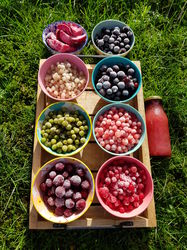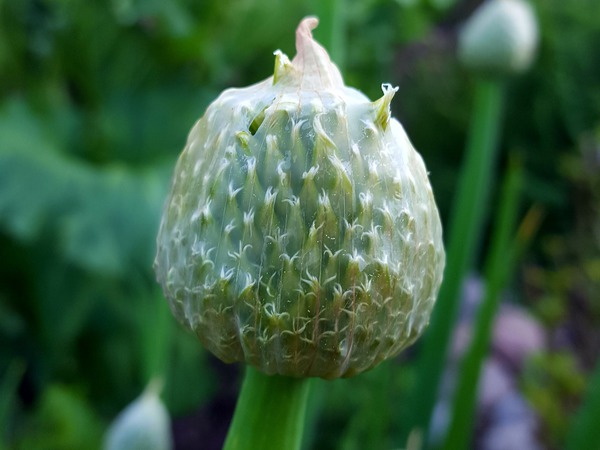 Are edible plants trendy? Of course, we as young plant producers in this sector are tempted to answer this question with a loud YES right from the start. Nevertheless, it is worthwhile to examine the question in a little more detail and more closely. This is the only way to better recognise and use the forces that affect our small plant sub-sector.
Are edible plants trendy? Of course, we as young plant producers in this sector are tempted to answer this question with a loud YES right from the start. Nevertheless, it is worthwhile to examine the question in a little more detail and more closely. This is the only way to better recognise and use the forces that affect our small plant sub-sector.
Convenience: fruit and vegetables can be bought in the supermarket
First of all, we have to realise that fruit, berry and vegetable plants in and from one's own garden rarely correspond to an economic necessity, or even to a sense of purpose. Buying ready-to-eat fruit and vegetables in the supermarket is in almost all cases not only more convenient but also cheaper. This realisation may certainly have led to the fact that fruit and berry plants tended to lose market share in the 1960s and 1970s and that the market shares of ornamental shrubs and plants, in particular, have grown strongly. After you had enough bread and butter on your bread, you wanted to explore the beautiful sides of life. Since the 1990s and increasingly since 2010, however, the counter-trend has also been observed: Edibles, fruit, berry and vegetable plants are continuously gaining market shares and also increasing in importance. This is also clearly evident in seed assortments; vegetable seeds are again far more important than flower seeds – at least that's what we hear from business partners in England. I would like to go even further: in my active professional career of a good 30 years, I have actually never experienced that our plant category was somehow seriously under pressure (always under the condition that the product is adapted to current needs). This is quite in contrast to plant groups such as roses, for example, where you experience gigantic fluctuations every 10 years, which can easily amount to 30-40%.

Picture: Welsh onion - a perennial vegetable for your own garden
In short: fruit, berries and vegetables from your own garden or balcony are 'in', increasingly since about 2010 – and this although the economic conditions have not changed fundamentally. Financially, it is still not worthwhile to produce fruit and vegetables yourself compared to the supermarket purchase. But what exactly is the physical and idealistic profit that overshadows the economic conditions?
Self-sufficiency: an old, but new trend
The self-sufficiency of the old subsistence economy, where every family produces its own main food on a more or less small patch of land, seems to be somehow transferred to modern times. Self-sufficiency is trendy and YouTube channels and blogs about the topic are booming. On the one hand, because the story is interesting (THEY really do it!), but also due to the role model function (it's really possible!). Inseparably connected to this trend are certainly also terms and 'feelings' such as directness (away from products and services that have been mediated x times), simplicity and sustainability. The term “grow yourself” summarises the trend well in two words: grow what you need yourself - and that includes all further processing, storage and above all cooking (see below). Ultimately, 'grow yourself' is the translation of 'do it yourself' into gardening!

Picture: high-yield, june bearing strawberry Parfum® Swiss Heart®
Nevertheless, I would like to repeat that the trend is a bit surprising because it does not meet the economic laws at all: that's exactly what is different with DIY, where it's almost always cheaper to build, assemble and tinker because I replace skilled labour with my own work. Why this cost advantage is certainly not true in the area of fruit, berries and vegetables would itself be an exciting topic worth thinking about. Price pressure and sometimes perverse market mechanisms have turned valuable foods into mere 'commodities' and mass products. No wonder that a counter-movement is developing that wants to control one's own life (and thus also one's own food) directly and make it worth living.
Anti-cyclical behaviour of the demand for edibles
Of course, people want their most important needs to be satisfied first and foremost, and eating enough is certainly one of them. So the demand for edibles (fruit, berry and vegetable plants) certainly increases in times of crisis: this applied to the oil crisis in 1973, but also to all subsequent smaller or larger economic crises. The demand for edibles increases when the supply no longer seems to be 150% secure, or even when one's own financial possibilities and economic prospects are clouded. Just recently we have experienced this again in the Corona crisis.
Now one could assume that in times of economic boom (let's just think of the past eight years) the demand would rather decrease – but this was clearly not the case...
So why do edible plants remain trendy even in times of economic boom?
Megatrends: immediacy, cooking, health, individualism
The contradiction cannot be completely resolved and the question cannot be answered definitively. Nevertheless, at a certain level of luxury (economic upswing, relatively high and historically unprecedented social security) a counter-movement seems to be taking shape that wants to go back to the origins. It seeks direct contact with food and wants to counter the alienation and mediation of living conditions (for everything there are service providers, suppliers, service providers of service providers) with a new directness: I cook myself and gain quality of life; I take care of my health myself and do not leave it to the medical faculties. Health and gardening with edibles naturally meet again in the most beautiful way: I eat what I have produced and harvested on my own responsibility. I have everything, my entire fate is under my control. Individualism certainly fits into this set of megatrends, which is not only positive but also likes to turn into selfishness: I take care of myself first, and then nothing else for a long time. Voluntary work, associations, political parties can all tell you a thing or two about it.
Lifestyle trend: The dematerialisation of the harvest as an experience
But back to our topic: fruit, berry and vegetable plants (also herbs) profit sustainably and tend to benefit more and more from this inward orientation, towards the individual, towards our own well-being. And for a long time now, this has no longer been about pennies and nickels – but rather about the good feeling of doing and having done the best for oneself (and one's own family). The quantitative thinking (of the old true self-sufficiency: yield, more yield, maximisation!) is being replaced by a new qualitative goal: one no longer wants to primarily harvest kilograms, the harvest itself becomes important. One does not only harvest fruits, but actually an immediate and real experience. It is quite fortunate that the simultaneous cooking trend makes the almost dematerialised experience physically tangible again!

Picture: freshly picked tastes best
Conclusion: self-sufficiency and quality of life, quantity and quality
Let's summarise: 'Edibles', i.e. fruit, berry, vegetable and herb plants have been supported for decades by the interaction of two trends that at first glance appear to be in opposition:
- Fear of cultivation in economically critical times plus old, but new self-sufficiency (which definitely wants to develop autonomously and independently of the economic environment)
- New immediacy and the desire for a different, not only quantitative quality of life and experience
As growers and plant producers, we should always be very aware of this double trend. It carries our small plant industry, and especially the edible plants for several decades reliably through many economically very varied times. But it is also not easy to implement in product design and customer approach. Although in many cases the buyer of edible plants is hybrid, so to speak, and thus certainly responds to both trends, it is very difficult at first glance to bring both to a common denominator: the promise of many kilograms of harvest and self-sufficiency – and the prospect of a wonderful experience, the enjoyment of home-grown fruit. But there is no getting around this dual strategy; the fruit plant as a mere lifestyle development will fail just as much as the banal attempt to sell a fruit production machine.
